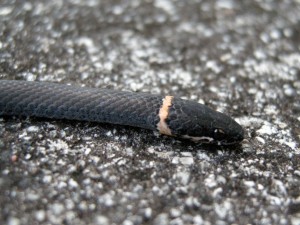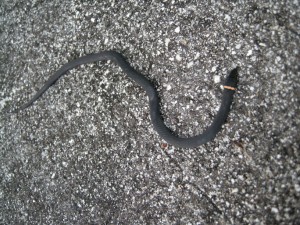We went to Yamato Scrub a couple of times this weekend; once very early on Saturday morning, and once again around sunset on Sunday. I just love the early morning light. Over the last year, this site really has become one of our favorite places to visit. Our first visit was back in November 2007, shortly after the place opened to the public. (Actually, all ERM lands are open to the public from dawn to dusk; it’s just that the trails and parking facilities had a grand opening back in the fall of 2007, and that’s what caught our attention about the site.)
It’s the closest spot to us where we can encounter nature in a nearly natural setting: we’ve had ospreys fly almost directly overhead, too close for our camera to catch the whole bird:

We’ve seen spiders and lizards and birds galore. We’ve seen the first breeding record for Florida of the Least Grebe:

Sunday, though, was the first time I saw a ringneck snake, despite these snakes having one of the largest geographic ranges of any snake in North America. They’re also among the most abundant (from hundreds to thousands per hectare according to one classic study). So why haven’t I seen one before? Well, these are very small snakes, no more than 18 inches when full grown. Like most small predators, they spend most of their time hiding (the ringneck hangs out under logs or in leaf litter and other debris). And they will flee rather than confront a larger being.
In fact, according to my Greene, snakes in general are among the weakest of all predators. They do everything possible to avoid actual combat. They’ll flee if possible; if cornered they’ll put on a visual display (picture a cobra rising up, or, my favorite although I’ve never seen it, a hognose snake who flops over and plays dead) or, in the case of rattlers and a few mimics, an auditory display. They’ll hiss, they’ll rattle, they’ll do their best to play on the mammalian fear of a legless slithering thing, to avoid having to match strength for strength.
Unfortunately for the ringneck we saw on the path at Yamato Scrub, all of its threat avoidance strategies were unsuccessful. It was a very small snake, probably not much more than a week or two old, and its back had been broken by someone or something. There was no predator in sight when we came upon it, though:

According to my Ashton, this snake “rarely attempts to bite, and even the largest specimen has a mouth and teeth too small to inflict a wound” (63). But, according to my Gibbons and Dorcas, “they may paralyze prey by chewing on it with their enlarged posterior teeth so that their toxic saliva can enter the lacerations. Although ringneck snakes rarely bite humans and are generally considered harmless, bites have sometimes been reported to cause a burning sensation” (66).
I wonder what got hold of this little guy, and where whoever it was went when we happened upon the scene?

You never know what you might find once you step outside your door…
